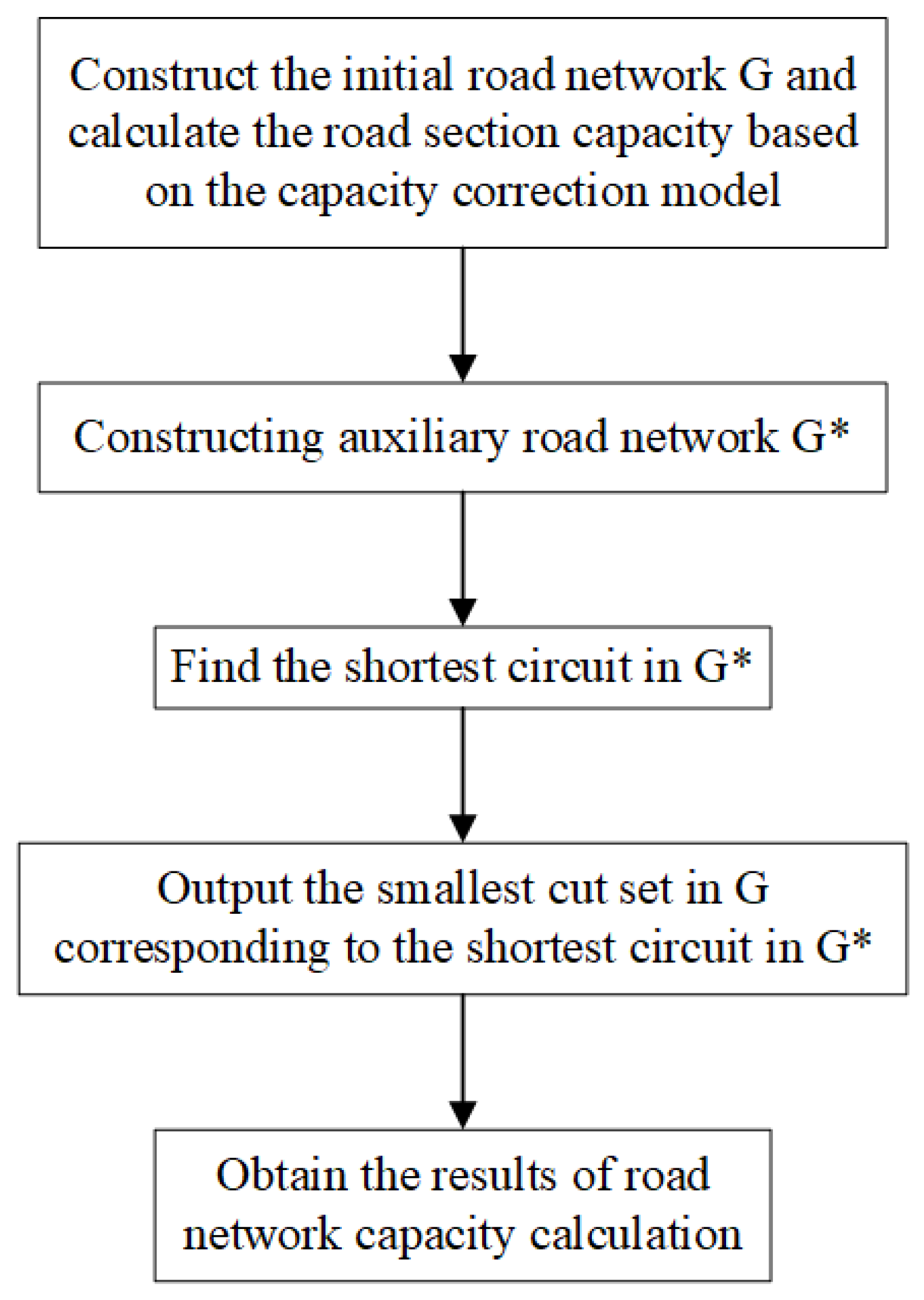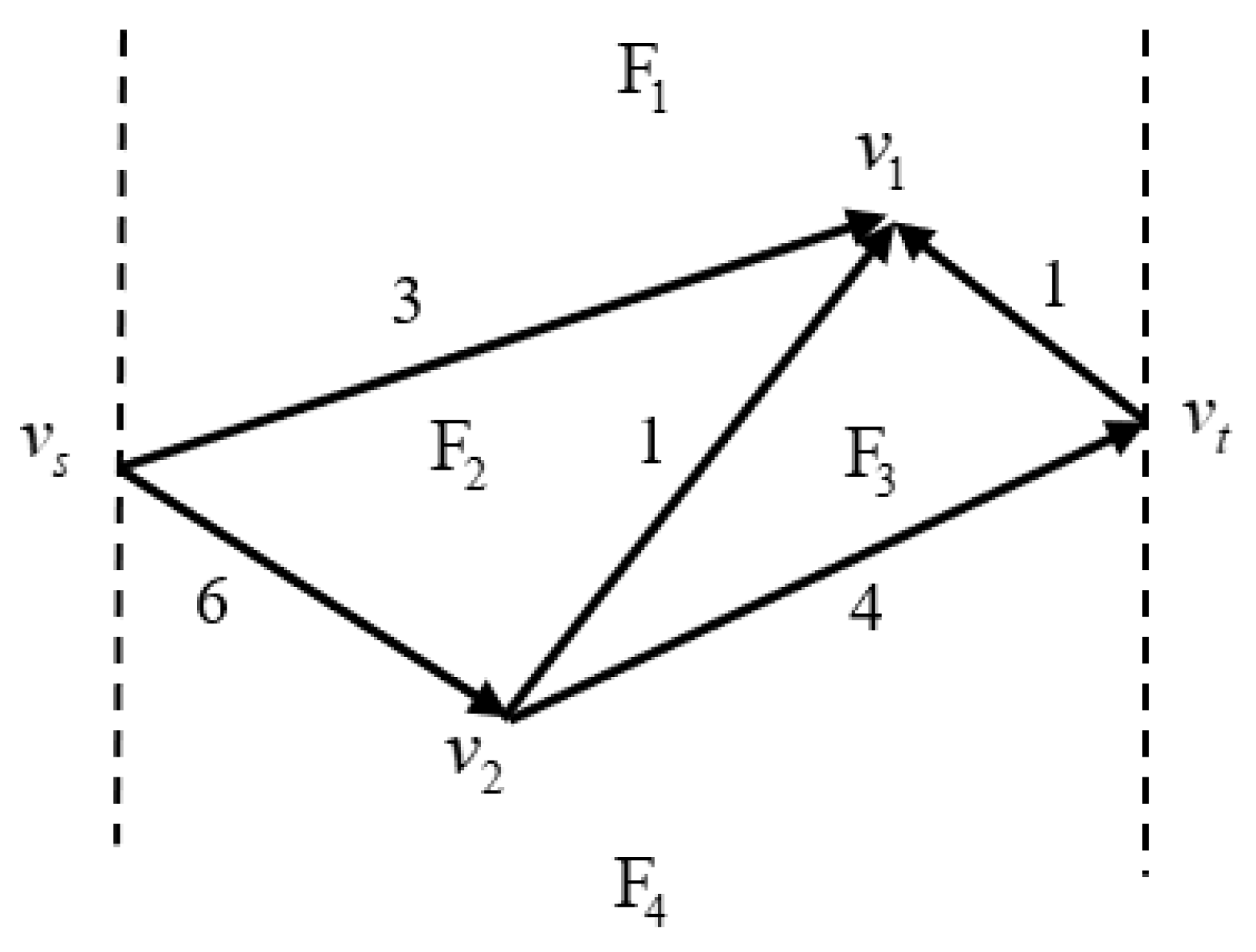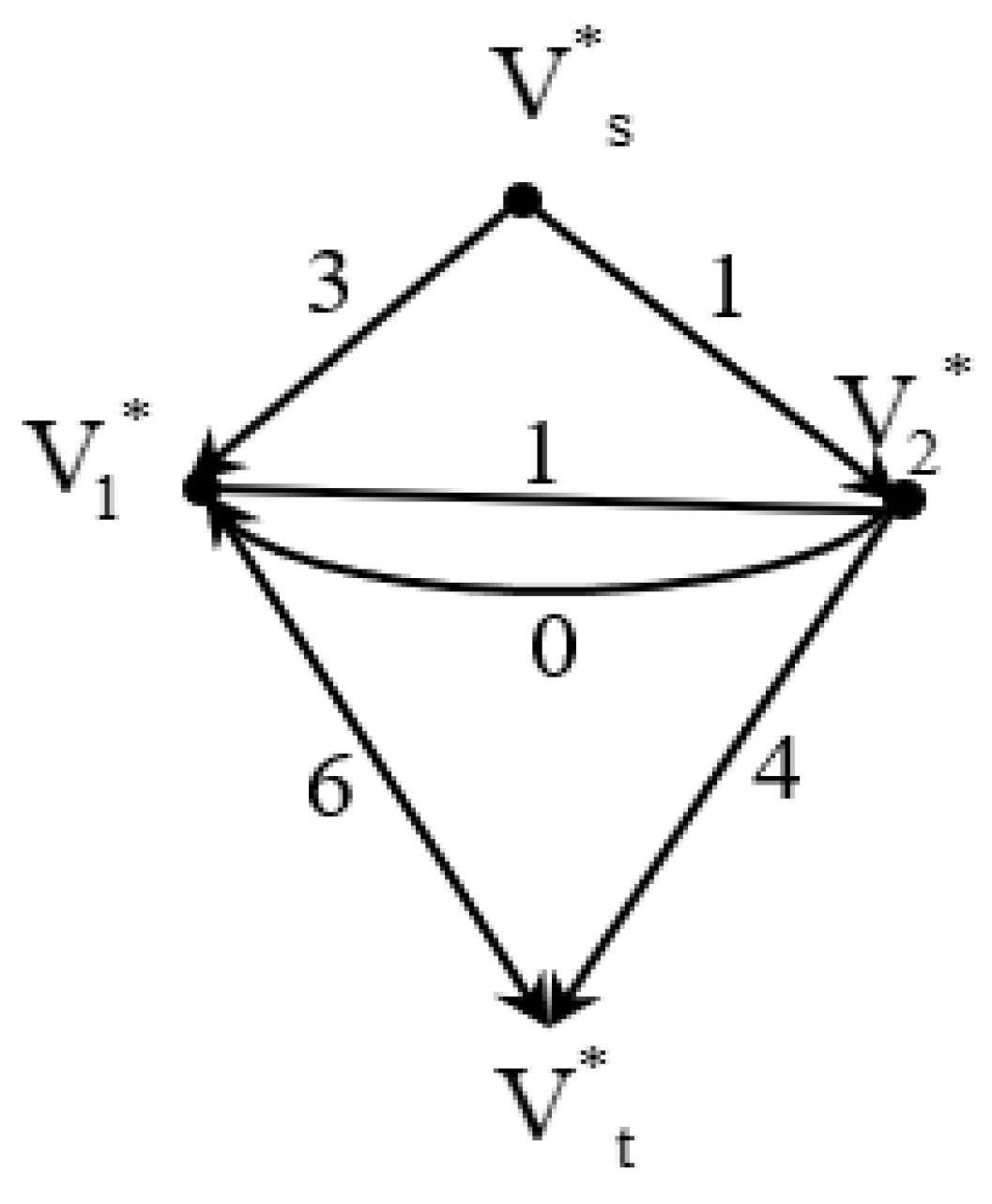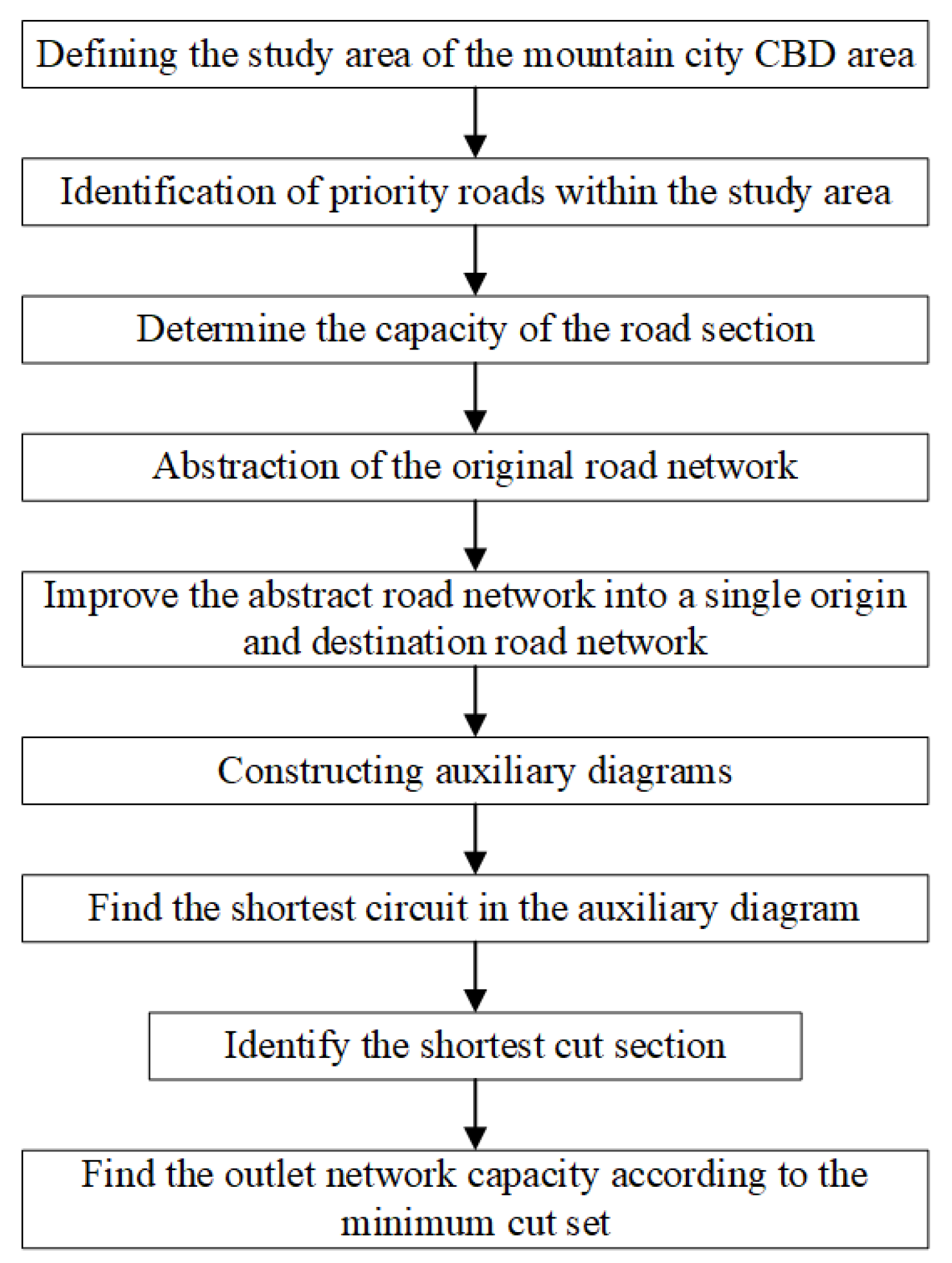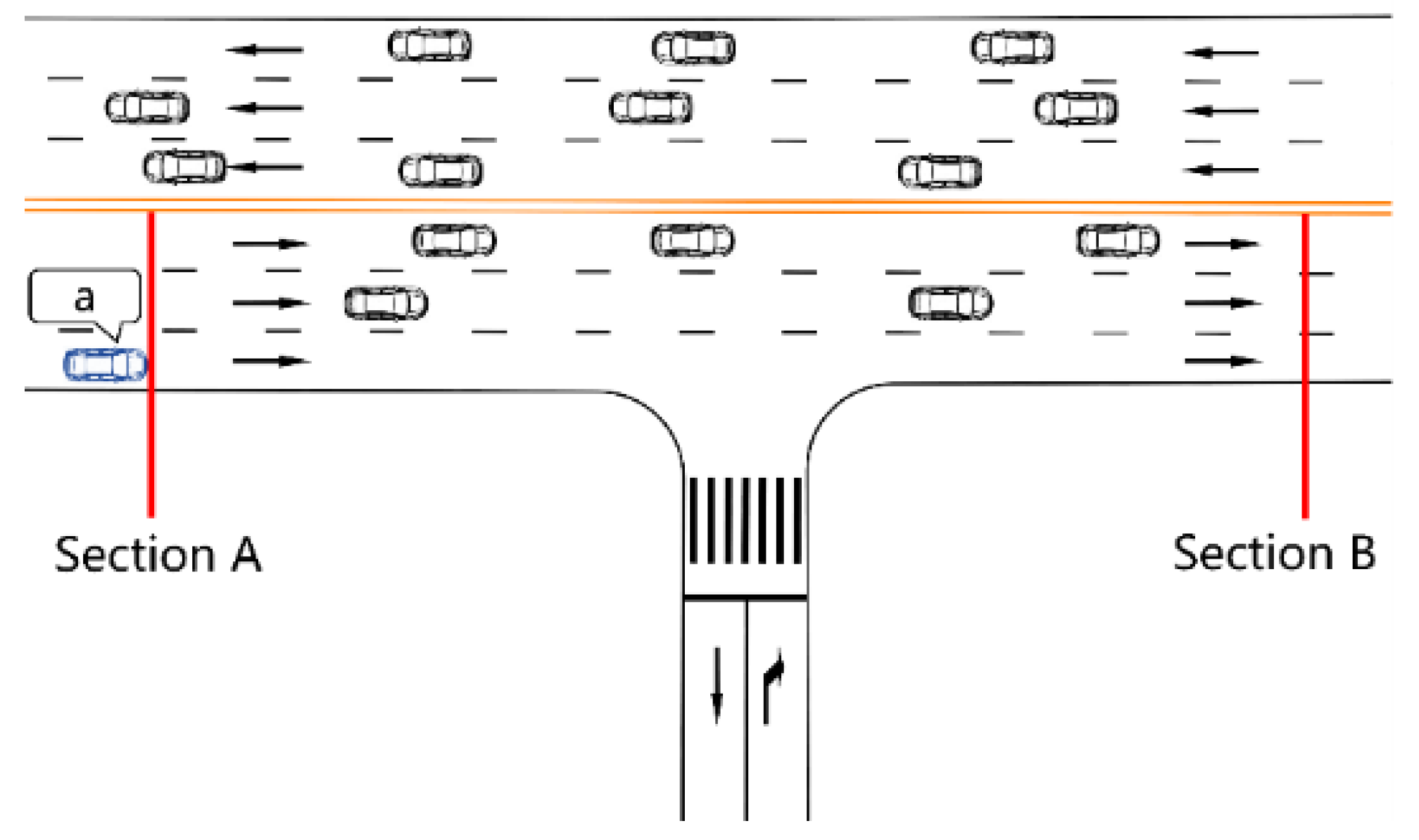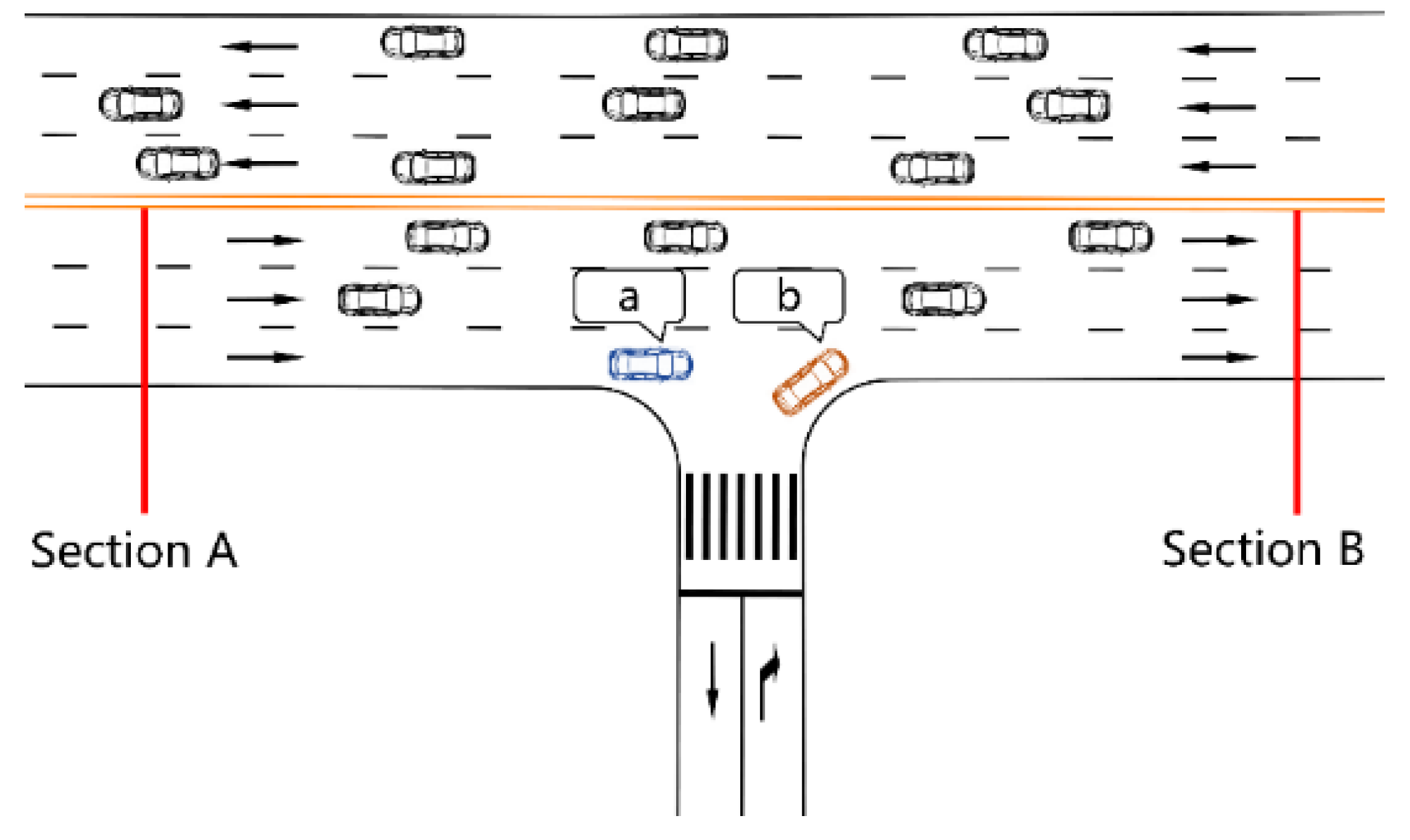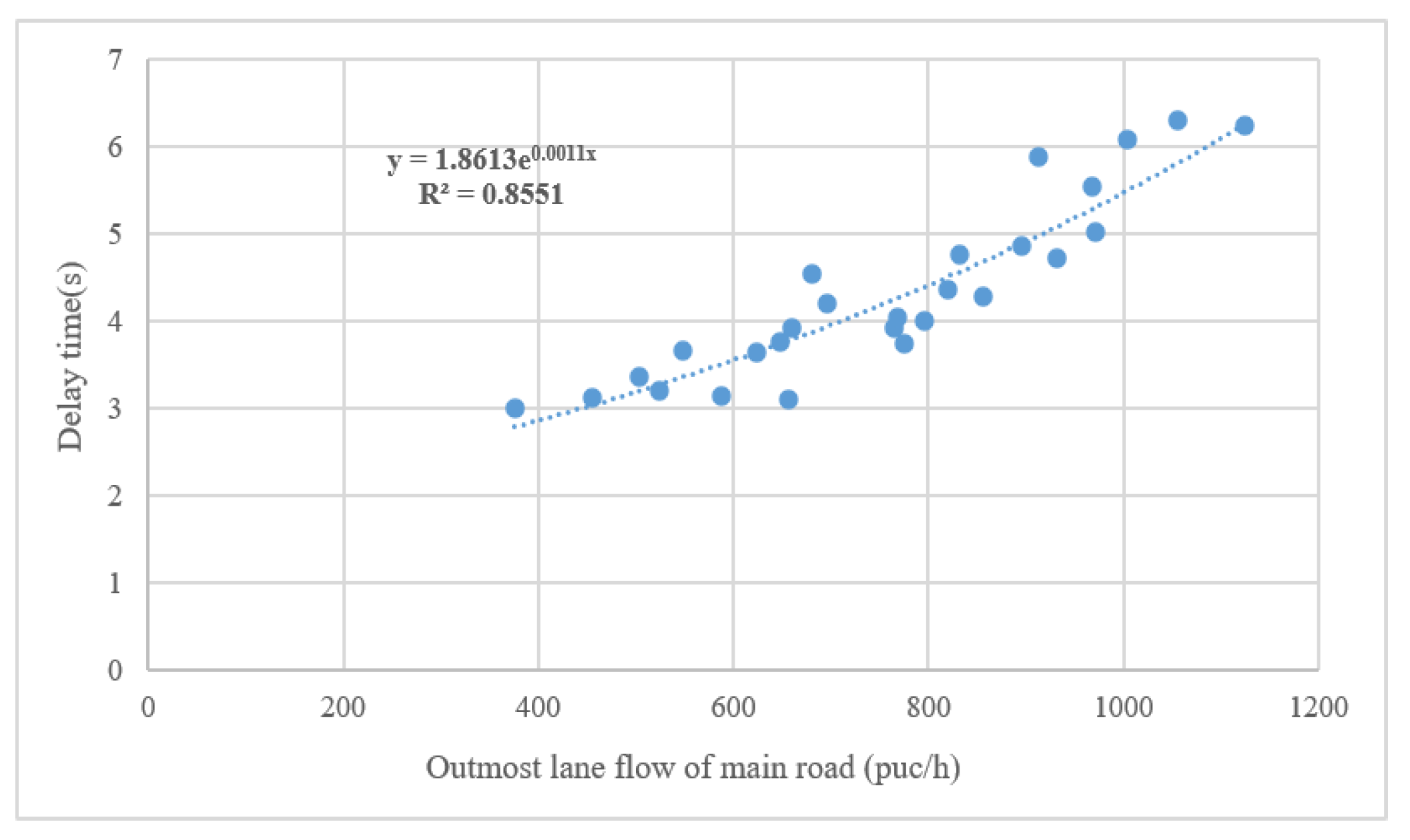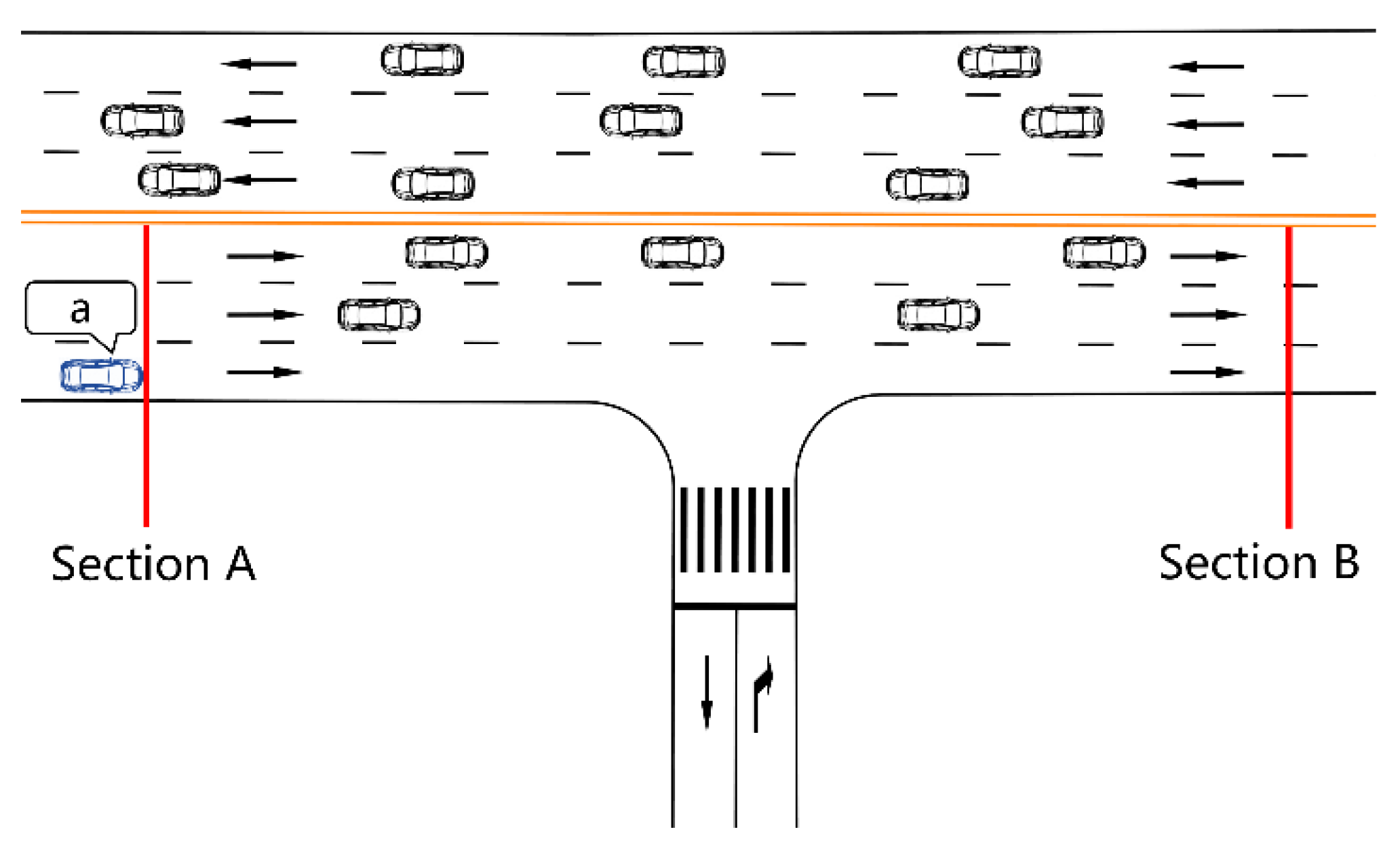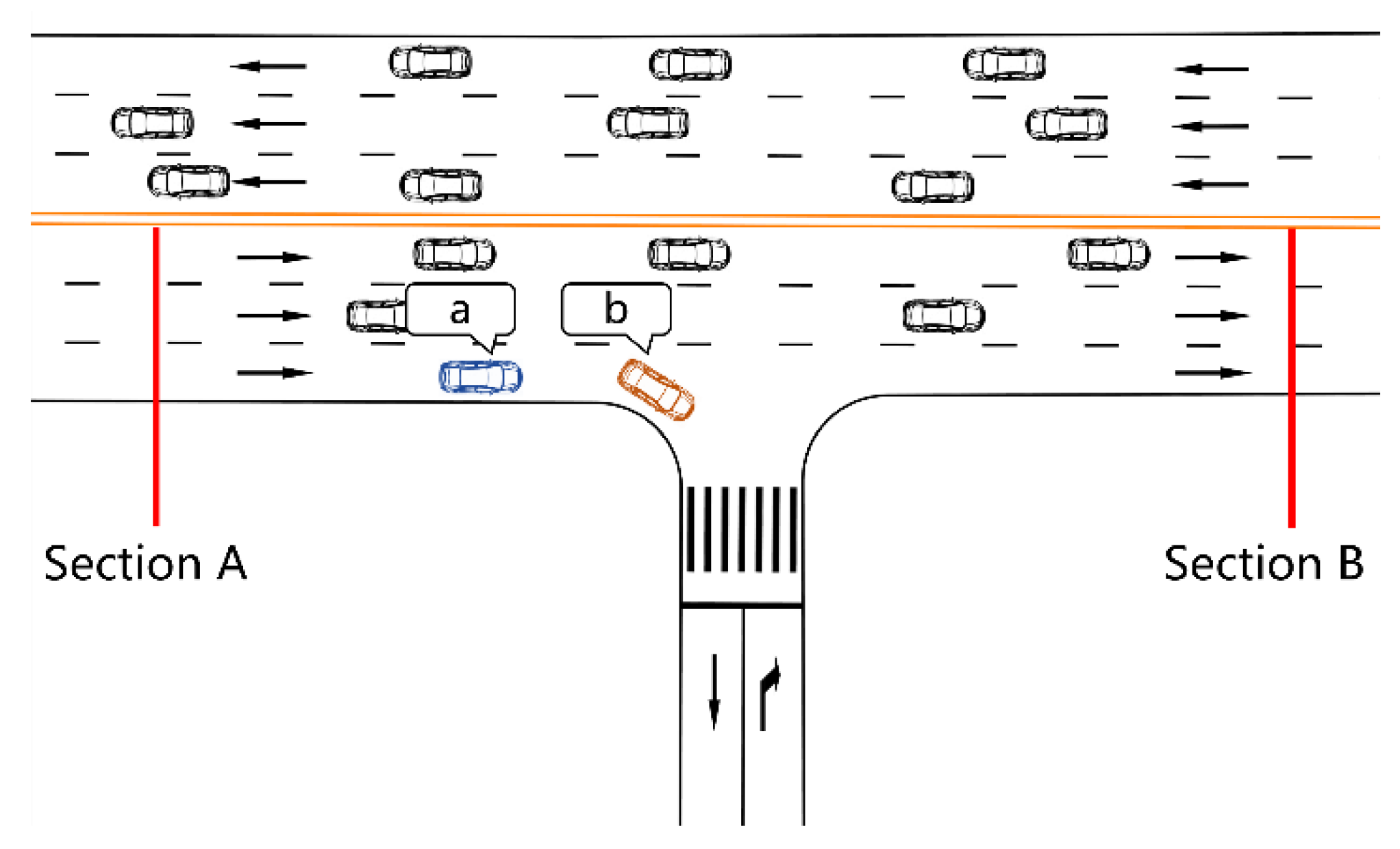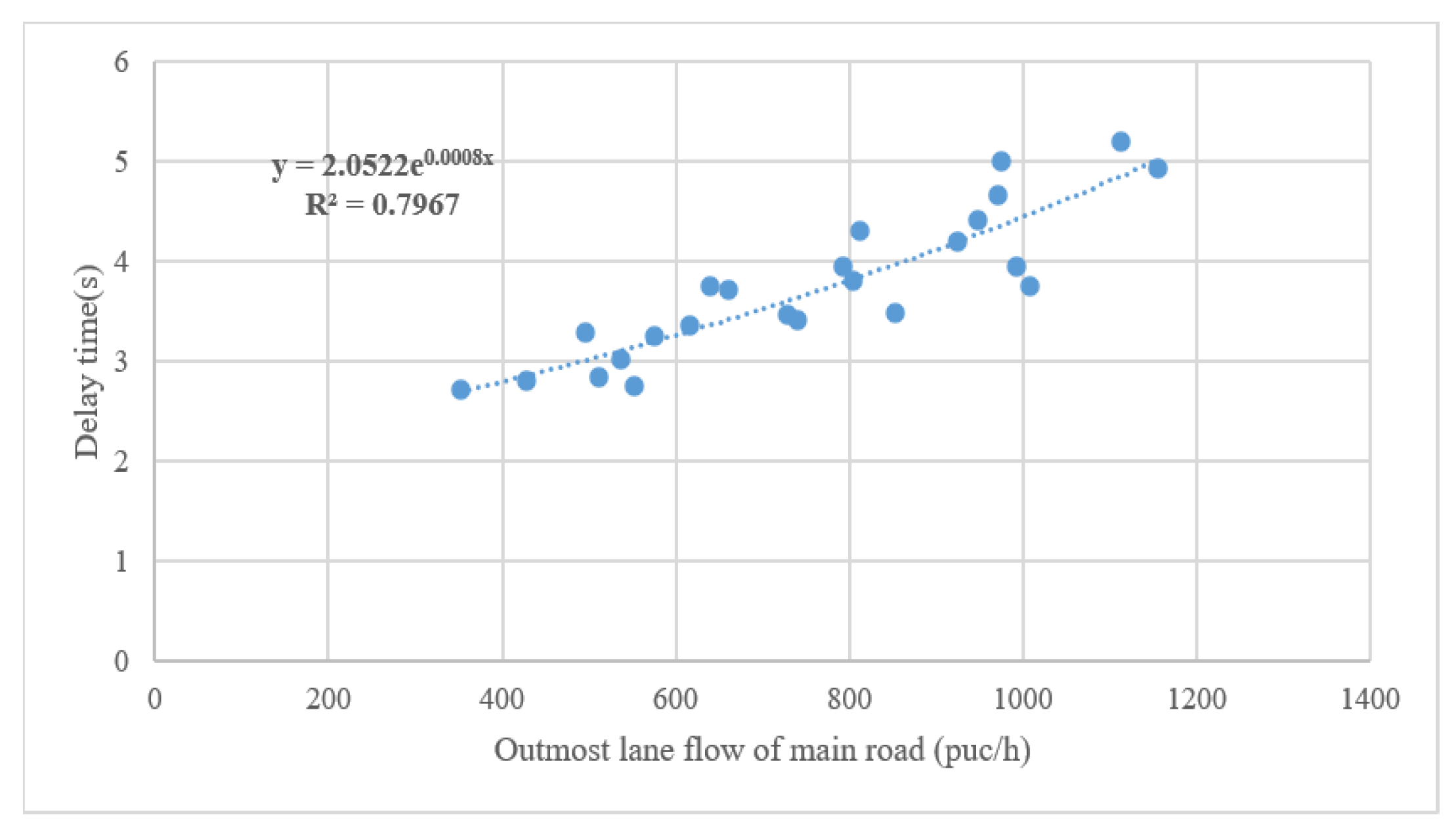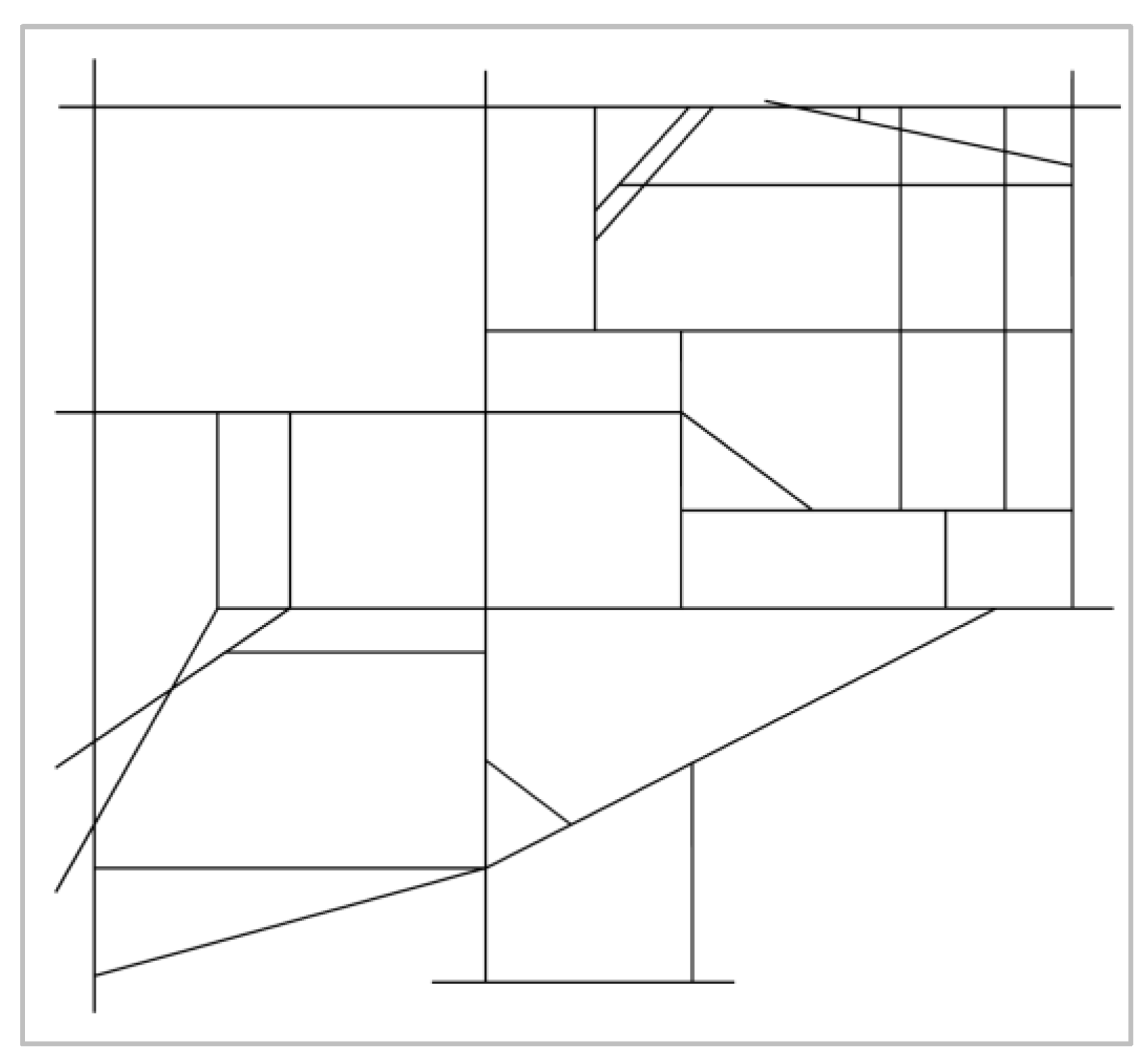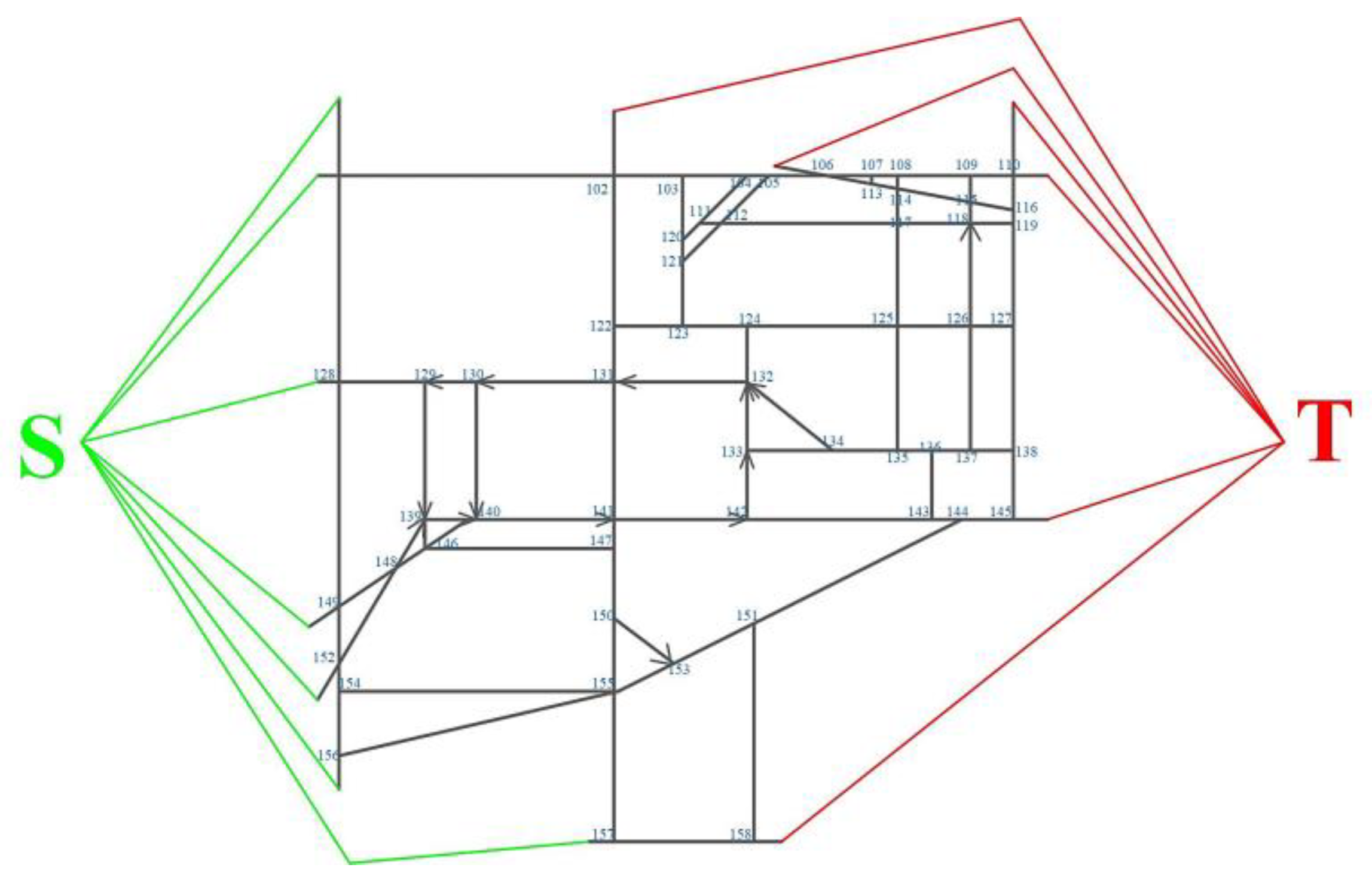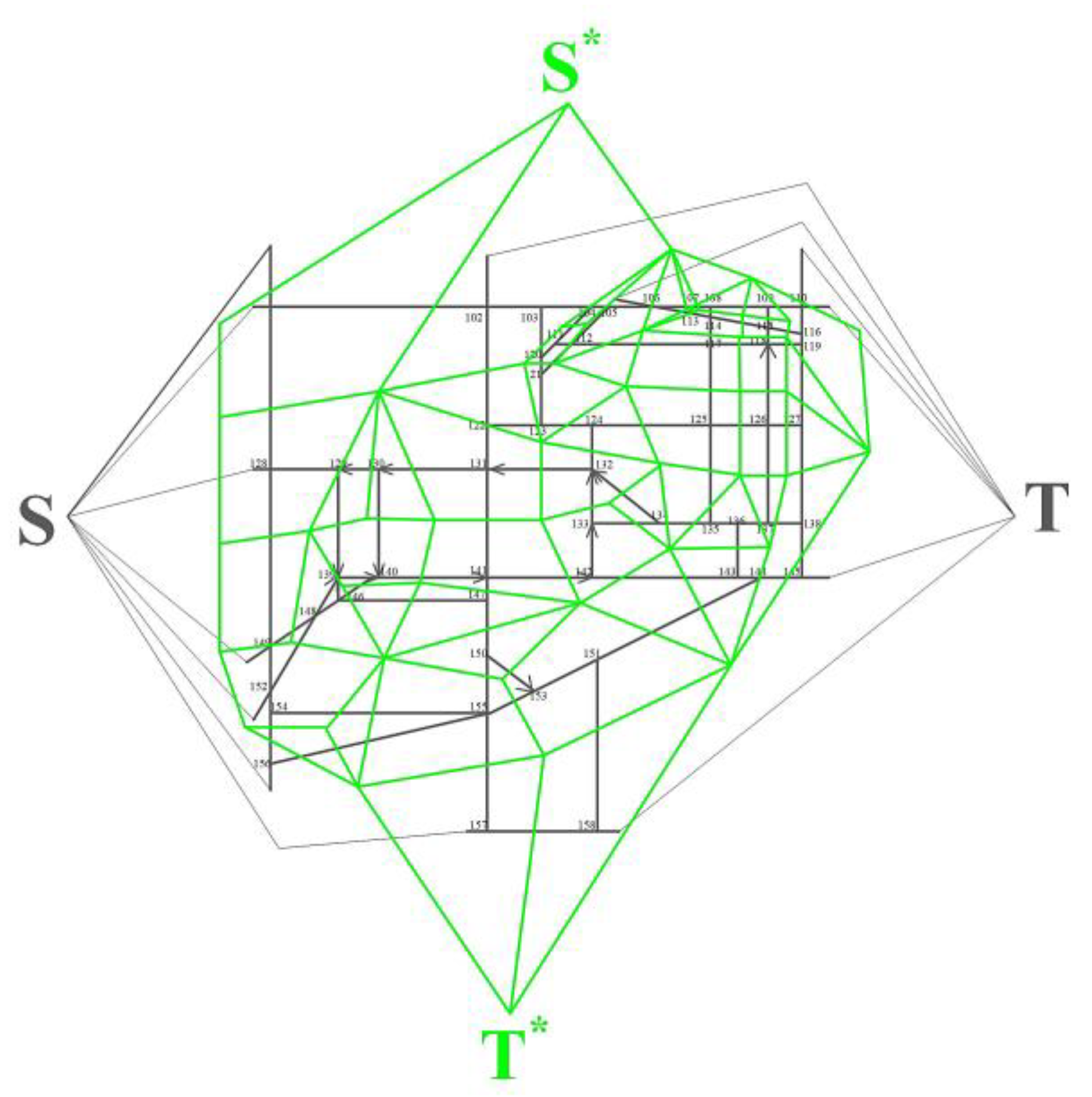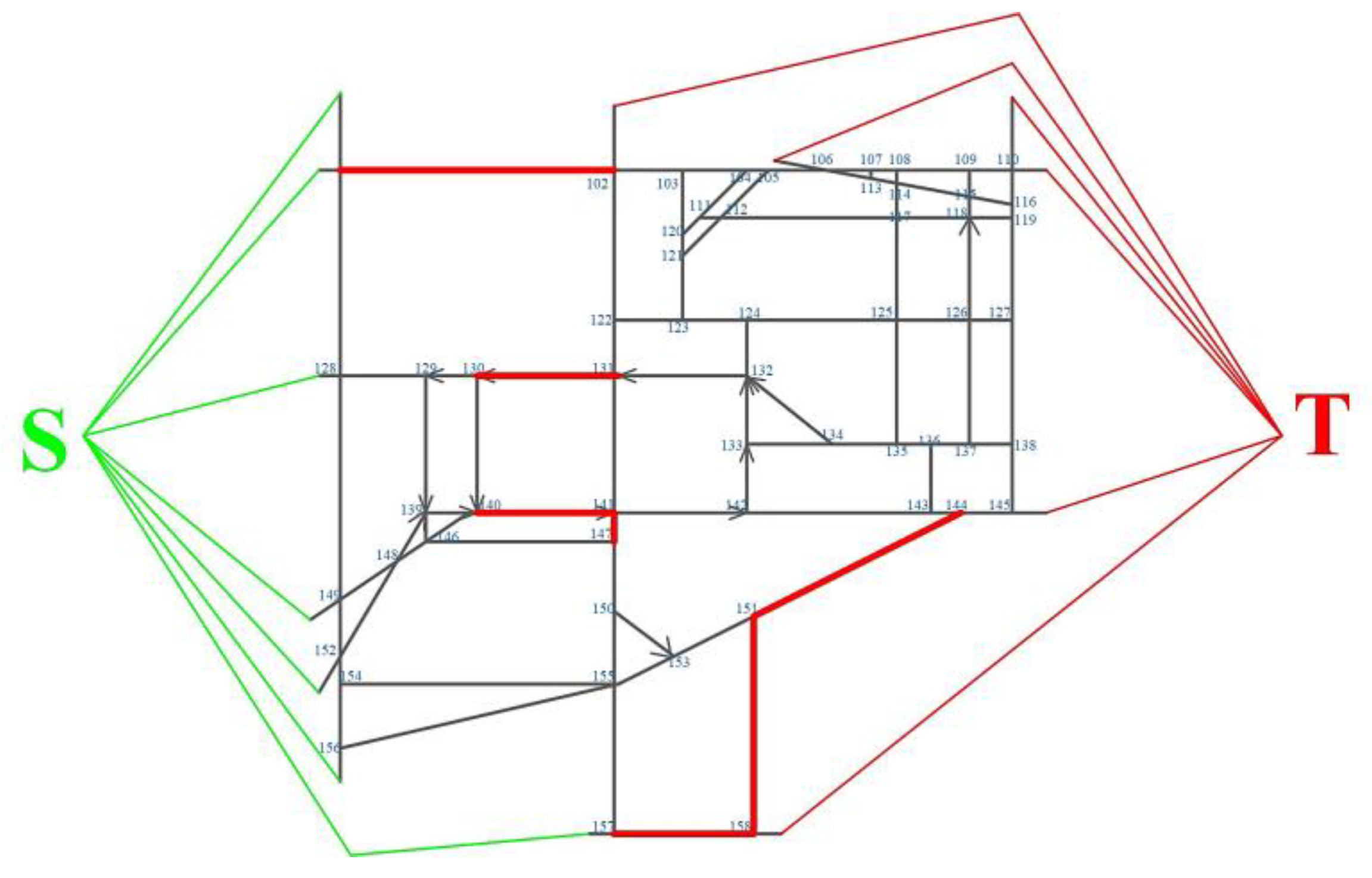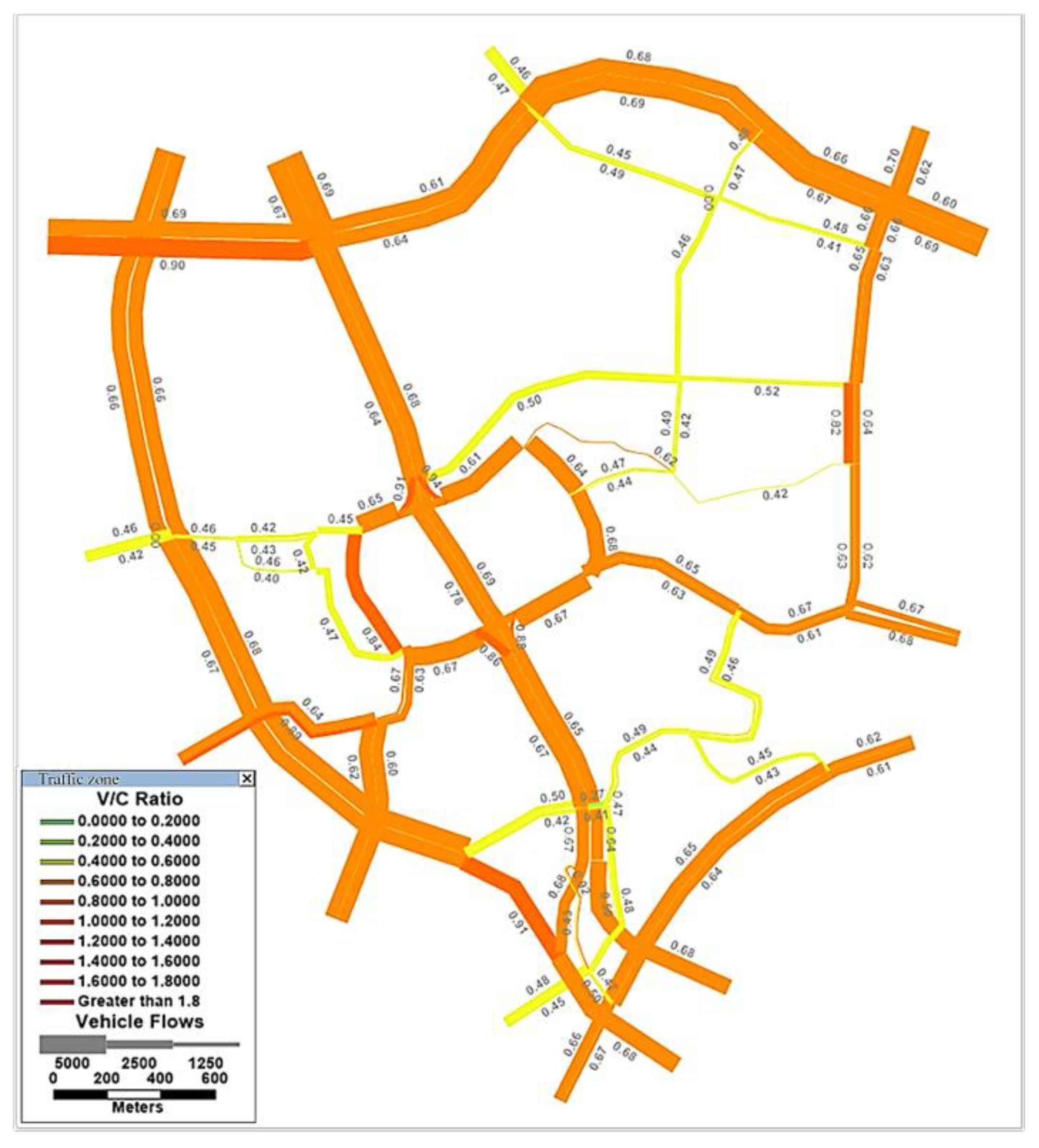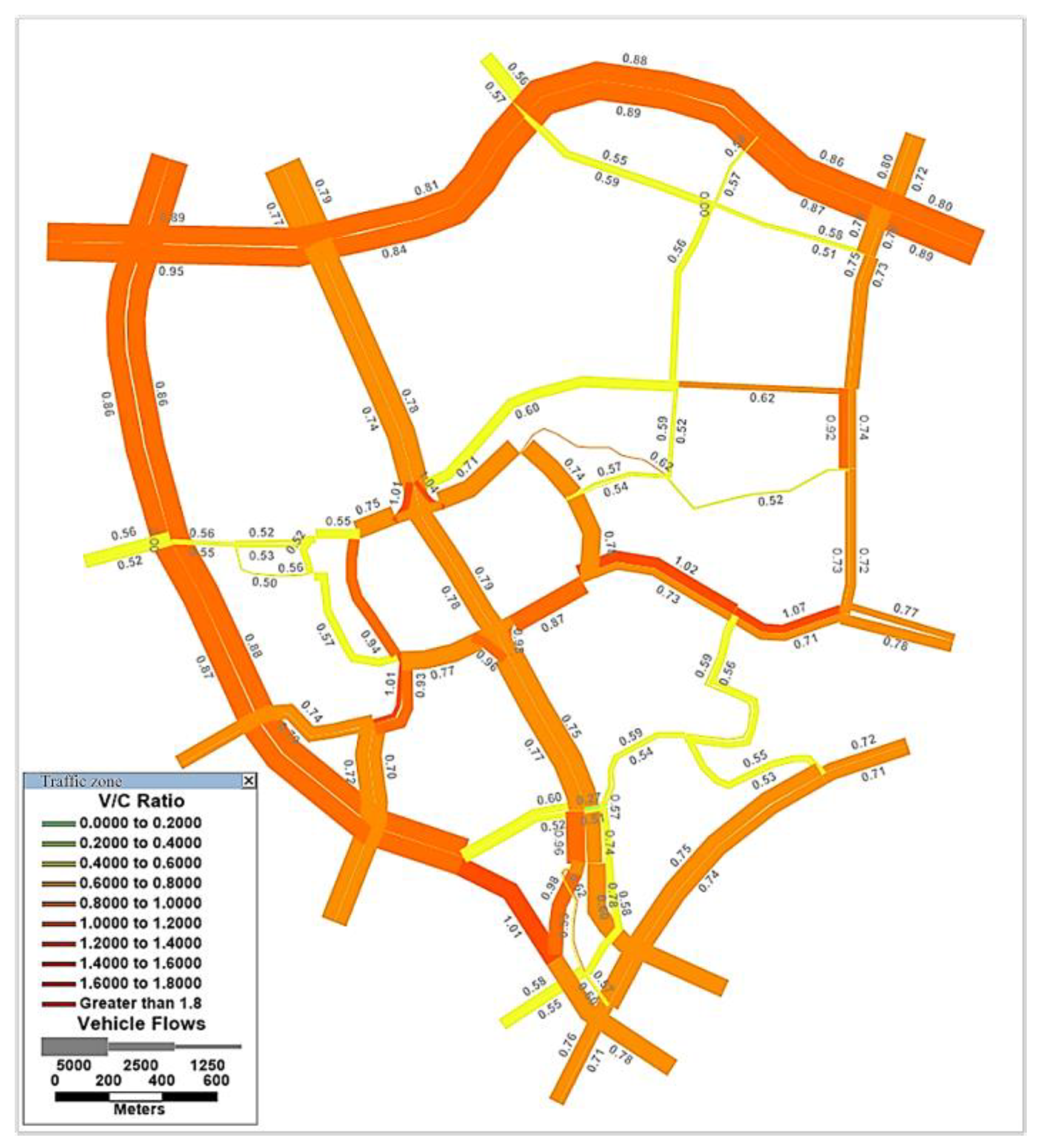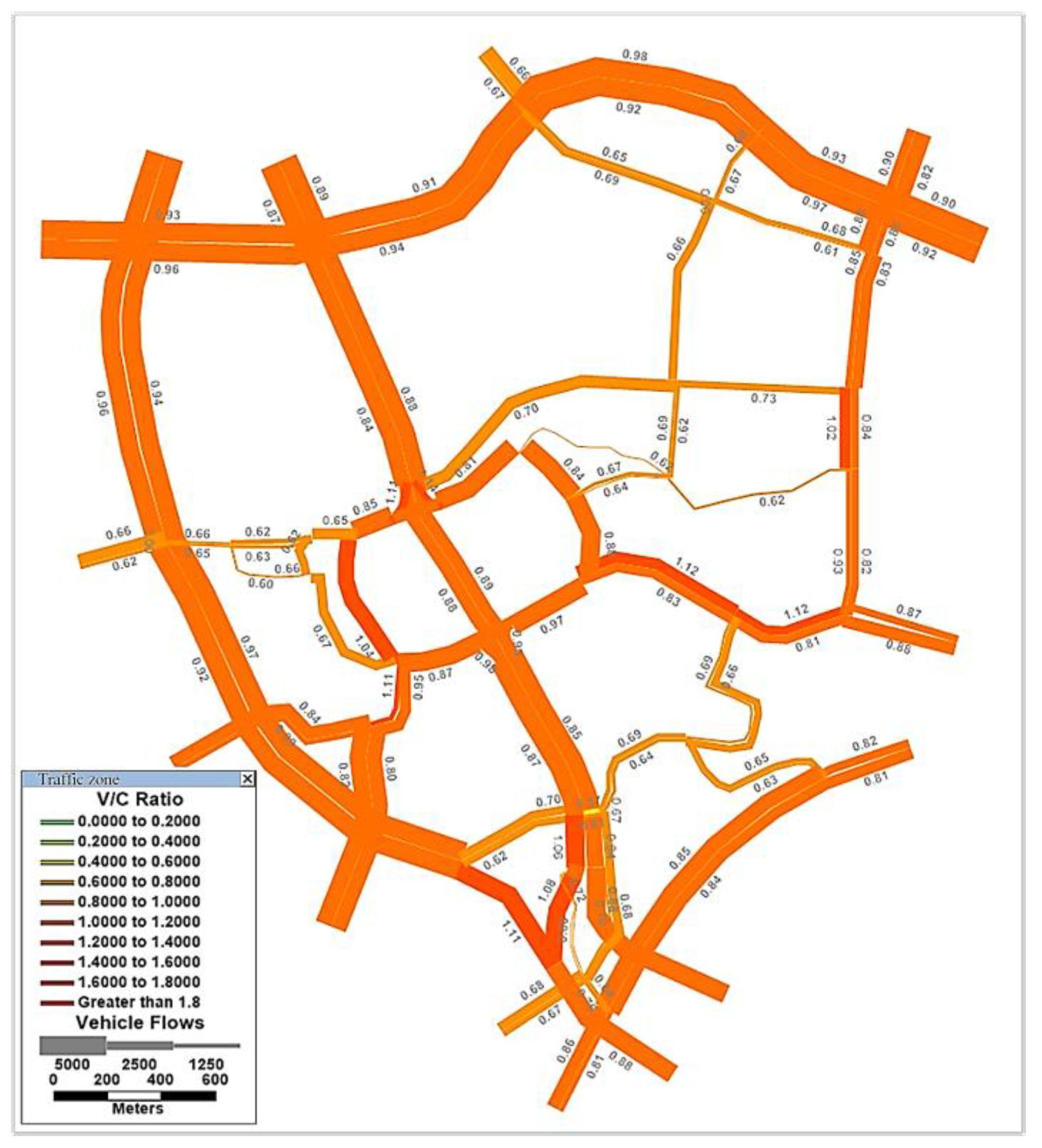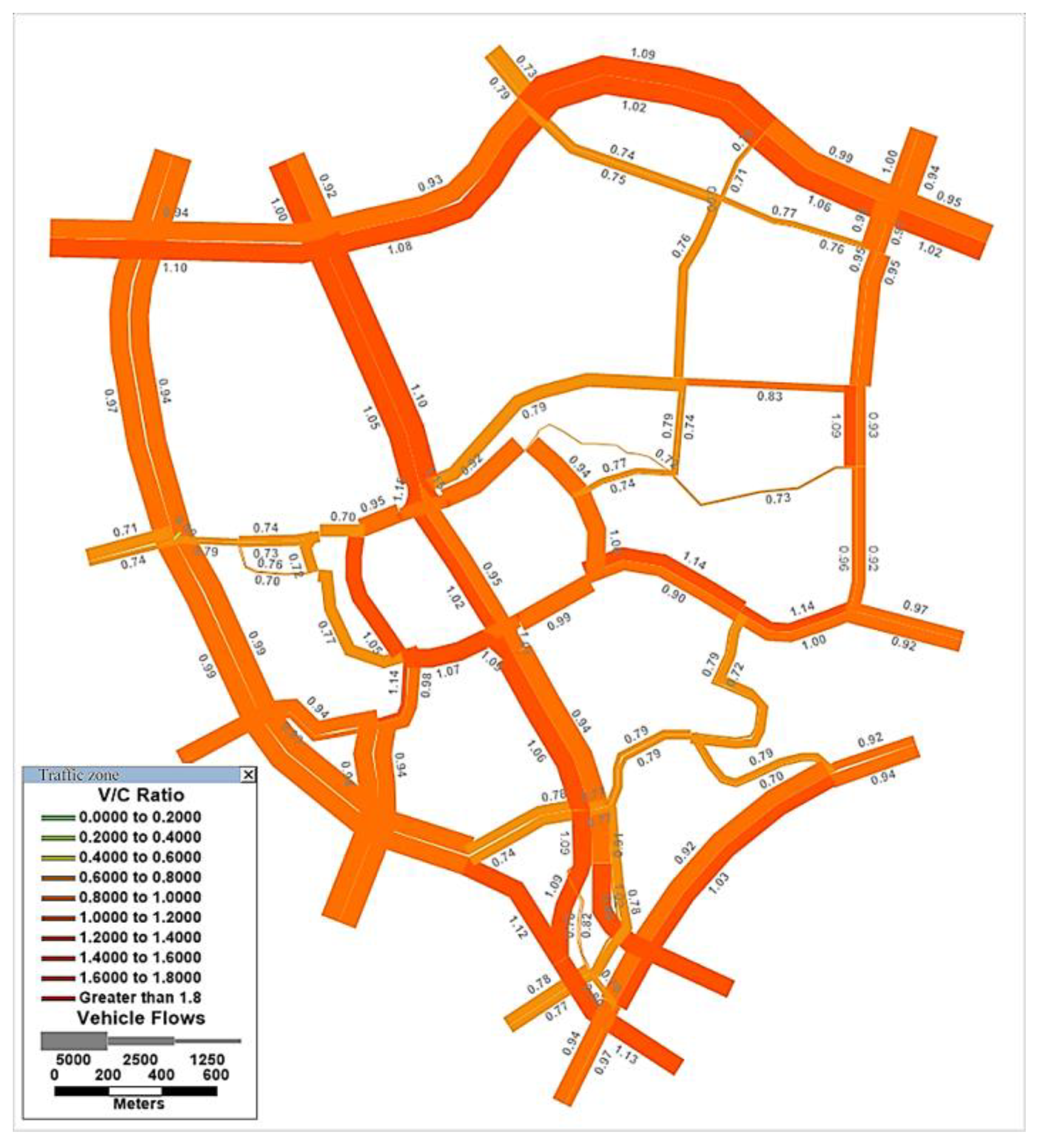4.2. Auxiliary Diagram Shortest-Circuit Model
Define a network
. According to cut-set theory, it is known that
is the set of points of
,
is the set of arcs of
, and
is the right of the network. The edges of
dissect the plane into several regions, each of which is called the face of
. One of the faces is unbounded and is called the outside, and the other is called the inside. For a network
, it is always possible to draw
on the left side of the network
and
on the right side of the network
. Suppose there are two vertical lines that pass through points
and
, at which point the outside becomes four parts, calling the part above
the top and the part below
the bottom. As shown in
Figure 2,
is the top of
,
and
are the inner part of
, and
is the bottom of
.
Suppose there exists a subset
of
satisfying
and
. The following set can be defined.
is the cut set of
. Equation (4) is called the capacity of the cut set
.
When two adjacent edges in the sequence of edges are at the boundary of the same side, the sequence is a set of edges in the network . Two and in are said to be connected to if and .
When two edges in the set commute with , the set is said to commute with . Also, the following theorem follows: if is a minimal cut set, then any two edges in are commutative with .
Because the shortest cut has duality with the minimum cut, the minimum cut set of the network can be obtained by finding the shortest cut between its auxiliary graph and the sending point to the receiving point .
The auxiliary graph is constructed as follows: each inner face F in has a vertex of corresponding to it, the top of has a vertex of corresponding to it, and the bottom of has a vertex of corresponding to it. When the faces in are adjacent, the vertices in the are also adjacent. Each pair of adjacent vertices of has a pair of directed edges with opposite directions between them, and its right is defined by the following method: let and correspond to the faces of , there exist directed edges and , and correspond to the faces of denoted as and , respectively, the common boundary of and is denoted as , and is a chain. If G* is drawn on G, can be drawn on and in . The pointing of , when coincides with is called the ’s by the direction determined by . Therefore, it is also obtained that the direction of is determined by the direction of , and the two directions of are opposite. The formula is as follows.
, and the direction is the same as that determined by .
and in the direction opposite to the direction determined by .
Specify the right on the edge
as
If , the right corresponds to the set of edges . If , the right is said to correspond to the set of edges and , similarly defining .
For a vertex adjacent to , only the directed edge and the weight on it need to be defined; for a vertex , adjacent to , only the directed edge and the weight on it need to be defined.
When computing the shortest path from
to
in the
length of a path
is the sum of the weights on its upper edges, denoted by
, which is expressed as follows:
The auxiliary graph
of the network
is shown in
Figure 3.
It can be seen that the auxiliary graph is constructed so that always intersects the edges in the corresponding in , and their powers correspond to each other. to also divides the vertices of into two parts, and the shortest cut in the auxiliary graph corresponds to the smallest cut in the network . The shortest cut in the auxiliary graph corresponds to the shortest cut in the network . Therefore, when all the shortest paths in the auxiliary graph are found, the set of minimal cuts in is obtained based on the fact that the edges in the auxiliary graph correspond to the edges in the network .
The approach is relevant in the following situations:
- (1)
Planar road network: This means that the network can be simplified to a road network in which the edges only interact at the vertices.
- (2)
A one-way road network with a single start and finish point: The network is typically multi-start and undirected, and therefore, the approach must be improved.
The auxiliary graph shortest-circuit algorithm was improved as follows:
- (1)
The road network abstraction is simplified into a directionless network.
Most of the roads in the urban road network are bidirectional; therefore, we simplify the road network into an undirected network.
- (2)
Determine the set of sending and receiving points.
The feasible flows of undirected graphs are typically reflected in multiple logistics with multiple sending and receiving points. For the flow problem of deterministic networks, the set of sending and receiving points in the network must be determined.
- (3)
Add two dummy vertices and to the network and connect each node in the set of sending and receiving points to the two dummy vertices, respectively. To ensure that the changed network is consistent with the actual network capacity, the capacity between and all sending points and the capacity between all receiving points and are set to infinity.
The main process of solving the capacity of the road network using this algorithm is to construct the undirected auxiliary road network from the undirected road network , find the shortest path in , and then determine the smallest cut set in . The sum of the capacity of the smallest cut set in is the capacity of the road network.
Combining the above studies, the construction of the auxiliary graph can be obtained as follows: for each inner face of , there is a vertex of corresponding to it; for the top of , there is a vertex of corresponding to it; for below, there is a vertex of corresponding to it; and the right of each side of is equal to the right of the corresponding edge in that intersects it. All edge weights of are obtained from the edge weights in , which commute about .
4.3. Construction of Road Network Capacity Estimation Model for Mountainous Urban Areas Based on Auxiliary Map Method
Based on the above analysis, the main process for constructing a road network capacity estimation model for mountainous urban areas based on auxiliary maps is as follows:
- (1)
Determining the study area as a mountainous urban area
The study area is typically the area enclosed by expressways or trunk roads around the business district.
- (2)
Determining the key roads in the study area
Throughout the study area, expressways, principal and minor highways, and feeder roads are investigated. Among them, “part of the branch road” refers to the study of a branch road if both ends are connected with secondary roads and above, and it serves as a traffic converter between secondary roads and above.
- (3)
Determining the capacity of the road section
According to the problems studied in this paper, it is known that the right of each road section should take the capacity of the road section. However, because of the mountainous urban area road network in the layout structure, function, and grade structure compared with the plain city, there are obvious characteristics that should be specifically studied in the mountainous urban area road network in the section of the capacity. The capacity of road sections in hilly cities’ regional road networks should be assessed as follows.
- (4)
Abstraction of original road network
The road network is abstracted. According to the abstraction principle of graph theory, intersections are abstracted as nodes, and the road sections are abstracted as arcs connecting the nodes.
- (5)
Transforming the abstract road network into a single origin and destination road network
All the “originating points” will be gathered to the originating point , and all the “receiving points” will be gathered at the receiving point .
- (6)
Construction of an auxiliary diagram
In the abstracted single origin and destination road network diagram, an auxiliary diagram is constructed according to the construction method of the auxiliary diagram.
- (7)
Determining the shortest circuit in the auxiliary diagram
Computer programming can be used to find the shortest circuit in the auxiliary diagram, the shortest circuit of all sections cut, and the minimum set of cuts in the road network. In this paper, Floyd’s algorithm is used to determine the shortest circuit in the auxiliary diagram.
- (8)
Finding the shortest cut section
Floyd’s algorithm is used to find the actual road section corresponding to the shortest cut in the auxiliary diagram, i.e., the minimum set of cuts in the road network.
- (9)
Finding the capacity of the road network according to the minimum cut set
After determining the minimum cut set in the road network, the capacity of the road sections corresponding to the minimum cut set is summed to obtain the capacity estimation result of the road network in mountainous urban areas based on the auxiliary map method.
The process of using the auxiliary diagram method to determine the capacity of the road network in mountainous urban areas is shown in
Figure 4.
4.4. Modified Model for Road Capacity in Mountainous Urban Areas
Passing capacity refers to a certain road, traffic, control, and environmental conditions, a point on the road (a lane, section, or intersection), and the maximum number of vehicles that can pass per unit of time, in units of equivalent minibus/s (hour, day and night) (pcu/s, pcu/h, pcu/d). This study focuses on the analysis of the impact of road openings along the road section capacity; the remaining impact factors on the capacity of the correction factor can refer to the correction criteria in the relevant research results at home and abroad.
- (1)
The road along the opening on the impact of capacity correction factor
Mountain city roads, owing to the impact of natural conditions, typically do not establish separate non-motorized lanes, resulting in the mainline road along the car openings being mostly directly connected to the mainline road’s outermost lanes, in and out of the openings, and the mainline road traffic easily forms conflicts and intertwined outermost lanes of the mainline road traffic caused by a certain impact. This is affected by the mountain city’s special land form; mountain cities on both sides of the main road establish fewer side roads, and travelers frequently travel directly from the roadside openings into the main road and cannot use the side road into the main roadway to reduce the impact on the main road traffic. Undoubtedly, this will have a direct influence on the capacity of the main road.
Vehicles approaching the mainline road from the opening and entering the mainline road generate traffic delays for vehicles traveling via the outermost lane of the road near the opening. A model was created to quantify the impact factor of openings along highways in mountainous urban regions on the capacity of the outermost lane of the mainline road.
where
is total delay caused by vehicles entering and exiting the opening to vehicles traveling in the outermost lane (s).
① From the opening into the mainline road, the impact on the mainline road vehicles
Owing to the mountainous urban area road along the opening directly connected to the mainline road, vehicles driving from the opening into the mainline road route will cause vehicles traveling in the outermost lane of the mainline to slow down to give way or stop to give way, waiting for its approach from the opening into the mainline road and the outermost lane of the mainline vehicles to begin to accelerate and gradually return to the current flow conditions of the speed. Consequently, vehicles exiting the opening cause some traffic delays for vehicles traveling in the outermost lanes of the mainline road. Traffic delays caused by vehicles entering the mainline road from the opening to the outermost lane of the mainline road are thus generated.
Let a car driving in the outermost lane of the main line passing through section A to section B (spacing l) consume time
, as shown in
Figure 5; when there is car b from the opening into the main line road, car a passing through section A to section B (spacing l) consumes time
, as shown in
Figure 6.
Therefore, there is a delay caused by vehicles traveling in the outermost lane of the mainline road when they enter the mainline road from the opening.
Through the observation of a large number of surveillance videos, it was found that when the outermost lane of the mainline road in the unit of time through the flow was small, the opening into the mainline road vehicles was less affected; that is, when the outermost lane of the mainline road in the unit of time through the flow increased, in the outermost lane of the mainline, the impact of vehicles driving from the opening into the mainline also gradually increased. Therefore, is related to amount of traffic passing through the outermost lane of the mainline road per unit of time.
We selected a number of roads in the Guanyinqiao area of Chongqing, through the monitoring video observation of multiple sets of
, to find its average value and record the traffic flow through the outermost lane during the same period; the specific results are shown in
Table 2 below.
Using Excel software to fit the above table as a function, the results are shown in
Figure 7, with
= 0.8465, a good fit, the establishment of the outermost lane of the mainline road in the unit of time through the flow rate, and the mathematical calculation model of
as follows.
where
is the flow rate per unit of time passed in the outermost lane (pcu/h).
is the delay caused by the vehicles entering the main line from the opening to the vehicles traveling in the outermost lane of the main line (s).
② Impact on vehicles on the mainline road by approaching the opening from the mainline road
Similar to the traffic delays caused by vehicles approaching the mainline road from the opening to vehicles traveling in the outermost lane of the mainline road, as the opening along the road in the mountainous urban area is directly connected to the outermost lane of the mainline road, vehicles approaching the opening from the mainline road will cause vehicles traveling in the outermost lane of the mainline to slow down or stop giving way and wait for their approach from the mainline road to the opening before the outermost vehicles begin to accelerate and gradually return to their speed under current flow conditions. Consequently, vehicles pulling into the opening cause traffic delays for vehicles traveling in the outermost lanes of the mainline road. The resulting traffic delay is caused by vehicles approaching the opening from the mainline road to the outermost lane of the mainline road.
Let a car driving in the outermost lane of the main line in passing through section A to section B (spacing l) consume time
, as shown in
Figure 8; when there is car b from the main line road into the opening, car a passing through section A to section B (spacing l) consumes time
, as shown in
Figure 9.
Therefore, there is a delay caused by vehicles traveling in the outermost lane of the mainline road when they enter the opening from the mainline road.
Through the observation of a large number of surveillance videos, it was found that when the outermost lane of the mainline road in the unit of time flow is small, the outermost lane of the mainline road vehicles driving from the mainline road into the opening has a smaller impact; that is, is smaller. When the outermost lane in the unit of time through the flow increases, the impact of the outermost lane of the mainline vehicles driving from the mainline road into the opening also gradually increases. Therefore, is related to the size of the traffic passing through the outermost lane of the mainline road in the unit of time.
A number of roads in the Guanyinqiao area of Chongqing were selected, multiple sets of
were observed through surveillance video and averaged, and the flow rate through the outermost lane during the same period was recorded, as shown in
Table 3.
Using Excel software to fit the above table as a function, the results are shown in
Figure 10, with R
2 = 0.8103 and a good fit. The establishment of the outermost lane of the mainline road in the unit of time through the flow and
of the mathematical calculation model is as follows:
where
is the outermost lane in the unit of time through the flow (pcu/h);
is from the main road into the opening of the vehicle on the main road to the outermost lane of traffic caused by the delay (s).
The mathematical expression for the total delay caused by all openings along the roadway to vehicles traveling on the mainline is as follows.
where
is the total flow from the opening into the mainline road in a unit of time,
is the total flow from the mainline road into the opening in a unit of time, and other parameters are the same as above.
- (2)
Lane width impact correction factor
The driving speed of a vehicle is influenced by the lane width. When the lane width is greater than 3.5 m, the freedom of vehicle driving is higher, so the speed will be increased. When the lane width is less than 3.5 m, the freedom of vehicle driving is influenced by the lane width, and the speed will be reduced. According to research results at home and abroad, the influence of lane width on vehicle speed has the following functional relationship.
where
W0 is motorway width.
The relationship between the variation in the coefficient of influence of lane width and vehicle speed is presented in
Table 4.
- (3)
The number of lanes affects the correction factor
Because vehicles traveling in a single lane are usually affected by traffic from other lanes in the same direction as well as traffic from opposite lanes without a central divider, multi-lane capacity is not equal to the direct sum of single-lane capacity and thus must be discounted for the roadway.
Table 5 shows the correction coefficient of multi-lane capacity based on relevant research results from both domestic and international sources.
- (4)
Intersection impact correction factor
Both the junction control mechanism and intersection spacing affect the intersection impact correction factor. According to domestic and international study findings, increasing the intersection spacing from 200 m to 800 m enhances the traffic speed and capacity by approximately 80%, and the relationship is essentially linear. The functional relationship between the correction coefficients of junction effects on speed and capacity is based on relevant research results from both domestic and international sources.
where
l is intersection spacing (m);
S0 is intersection (inlet road) effective passage time ratio.
If the above formula calculates , then take .
